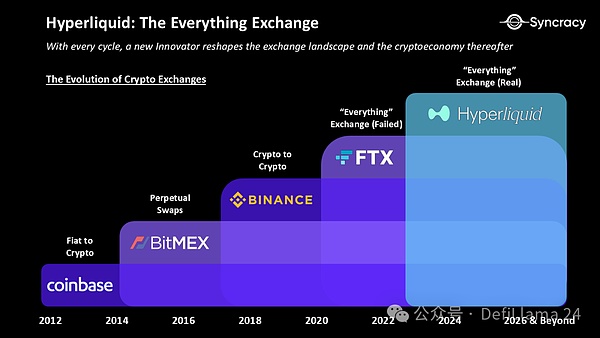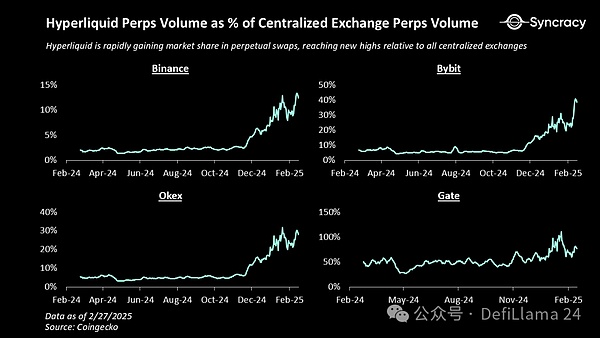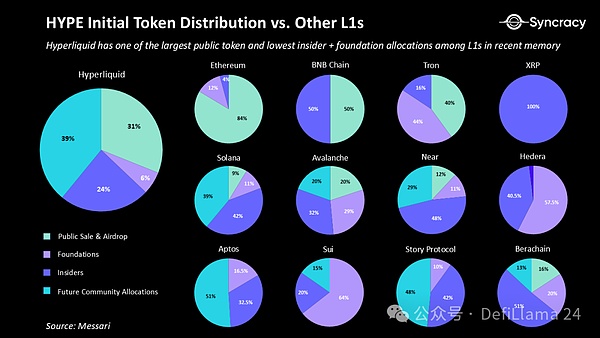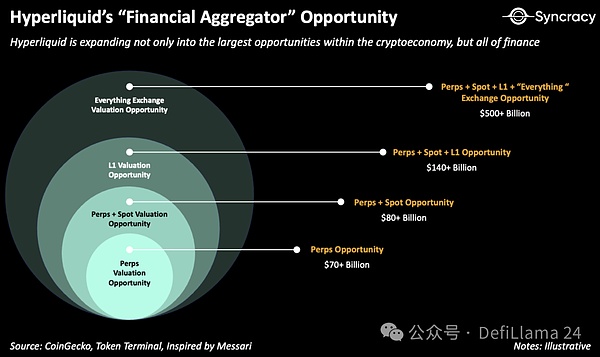Original author: Ryan Watkins Translator: LlamaC
Main text
Syncracy established a large position in HYPE in the fourth quarter of 2024. In the first quarter of 2025, as the Hyperliquid story accelerated beyond expectations, our conviction strengthened, and Syncracy further increased its position.
We believe Hyperliquid has a unique revenue engine that fuses an exchange and a smart contract platform, which makes it likely to become the blockchain that generates the highest transaction fees in the crypto economy. In addition, its vertically integrated design combines these two businesses through a unified interface, allowing Hyperliquid to aggregate users more efficiently than any of its peers to date, providing a structural advantage for its ambition to accommodate all of the world's finance.
This exchange alone has the potential to disrupt Binance’s position in the long term, offering superior performance to its decentralized peers and structural advantages over centralized exchanges in terms of cost, accessibility, auditability, composability, security, and asset availability. At the same time, its smart contract platform has the potential to become one of the major application ecosystems, leveraging Hyperliquid’s exchange and inherent trader base as a foundation for growth.
We estimate the combined market size of its exchange and smart contract platform – which we call the “financial aggregator” opportunity – to be worth tens of billions of dollars over the next few years.
Below we share our arguments.

Note: Inspired by Frictionless Capital
The Art of Progressive Decentralization
Trading is one of the clearest killer apps of the crypto economy to date, yet the majority of trading still takes place in centralized venues. Is it possible to build a decentralized exchange similar to the one Bitcoin originated from? That’s the question Hyperliquid co-founder Jeff Yan is trying to answer when he creates his new exchange from the ashes of FTX in 2022.
After a successful career in quantitative trading at Hudson River Trading, Jeff found himself in a comfortable position to take a bold entrepreneurial risk, founding Hyperliquid alongside his Harvard classmate and co-founder Iliensinc. Notably, the team did not accept any outside funding from venture capitalists, instead deciding to completely bootstrap the entire project. This was a key decision that allowed the team to focus on building a product they believed in, free from external pressures, and ultimately distributing the majority of ownership to the community.
Two years later, Hyperliquid has become one of the fastest growing projects in the crypto economy, capturing over 60% of the market share in the on-chain perpetual swap market. In the process, it has played a key role in driving the shift to on-chain
perpetual swaps
trading, which now accounts for 12% of global trading volume.

What is the key to Hyperliquid's success?
It all starts with the team's product-first philosophy. Rather than prioritizing ideological purity, such as pursuing maximum decentralization from the outset, the team is committed to providing the best on-chain trading experience. This strategy is best understood as progressive decentralization — a practical approach to building successful projects in the cryptoeconomy that involves teams first finding product-market fit and then gradually giving up control over time.
The key insight the team understood was that while decentralization and open source software were critical to long-term reduction of counterparty risk and enabling greater product scalability, most users preferred performance and ease of use over strict adherence to cypherpunk principles. As a result, over the two years leading up to the HYPE token launch, the team worked tirelessly to refine the platform by interacting directly with traders.
This feedback loop proved invaluable, as the Hyperliquid team often implemented feature requests and bug fixes within hours, building a deep trust within the community. It also led to the development of key product features such as order cancellation priority for traders, enabling market makers to quote tighter spreads, and Hyperliquid Vault, enabling exchanges to quickly onboard liquidity for new trading pairs. The result is a high-performance chain with a built-in order book (CLOB), capable of handling a throughput of 100,000 transactions per second (tps) and achieving sub-second finality - an order of magnitude improvement over its peers. With trading volumes set to grow exponentially towards the end of 2024, the Hyperliquid team has executed its most ambitious move to date - airdropping 31% of the token supply to its users. The airdrop was an overwhelming success as Hyperliquid had demonstrated product-market fit - in stark contrast to most projects that publicly list their tokens too soon.

Critically, the HYPE token also had clear intrinsic value, with fees annualized at the time

Everything Exchange
Exchanges are winner-takes-all markets where liquidity network effects, scale efficiencies, brand value, and regulatory barriers concentrate trading activity in the hands of a few dominant players. This model has shaped financial markets for centuries, cementing the dominance of leaders like CME in derivatives, NYSE and Nasdaq in equities, and Binance in centralized crypto. Yet, despite its size, no exchange has ever been able to fully unify liquidity across multiple asset classes on a single global ledger - a concept we call the "Everything" Exchange.
Bridging this gap requires more than just dominance in a single market - it requires infrastructure that can seamlessly integrate across multiple asset classes, unify liquidity, and scale globally. This is where Hyperliquid's design differs from traditional exchanges by offering a vertically integrated system that runs on its own high-performance blockchain, integrating liquidity across both spot and derivatives markets.
Blockchain-based exchanges offer structural advantages in auditability, efficiency, security, composability, and accessibility. Instead of entrusting their assets to risky, opaque, centralized entities, users can custody their assets themselves and trade in a global, 24/7, near-instant settlement market using autonomous smart contracts as intermediaries.
These benefits are not just theoretical. They are already driving the growth of current on-chain transaction volumes. This trend can be observed not only in the data, but also in the strategies of the two largest exchanges in the industry, Binance and Coinbase, which have launched their own blockchains, Binance Smart Chain (BSC) and Base, respectively, to get a head start in this shift. Hyperliquid recognizes this opportunity and has taken the first step by expanding into the cryptocurrency spot market. The solution starts with enabling users to send native assets from blockchains such as Bitcoin, Ethereum, and Solana to Hyperliquid through a standardized interface. This is a first for on-chain exchanges, as all exchanges historically have either been single-chain or only do spot trading. Hyperliquid will become the only on-chain central limit order book exchange that offers multi-chain spot and derivatives markets at the same time, replicating the experience of centralized exchanges on-chain for the first time.
Currently, Hyperliquid only supports HYPE and BTC, two large-cap assets, in its spot market. It has become one of the top 10 DEXs and top 5 chains in the world by DEX trading volume. We expect it to quickly climb the rankings as it brings in the cryptoeconomy’s largest assets for trading, adding nine-figure revenues within its first year after launch, assuming spot volumes reach 30% of perpetual swap volumes (a typical ratio for exchanges serving both markets).
Hyperliquid should continue to outperform its centralized competitors with the following advantages:
Cost - Significantly lower trading fees and operating overhead
than centralized exchanges like Binance left;">Accessibility- Easier for users to onboard due to its global permissionless nature
Auditability- Easy to verify using basic public key cryptography inherent to blockchain
Composability - Easy for third parties to build on top of it (e.g. builder code) - Security - Self-custody with increasing on-chain decentralization over time leaf="">Asset Availability- Faster and more transparent process for listing assets
Additionally, these advantages position Hyperliquid to eventually expand beyond blockchain-native assets. Astokenizationefforts accelerate, Hyperliquid’s opportunities could span the full range of assets globally, including currencies, stocks, bonds, commodities, real estate, and even niche markets like sports betting and prediction markets. In fact, we believe this shift is all but inevitable. As wallets become more ubiquitous, asset issuers will have an increasing incentive to list on public blockchains to tap into a global investor base for broader distribution and to obtain the lowest cost of capital.
Taking a broader view, we estimate the opportunity within the cryptoeconomy to be currently valued at over $140 billion. Additionally, we estimate the opportunity beyond the cryptoeconomy, including all asset classes and exchanges globally, to be valued at a minimum of
over $500 billion. This does not include private exchanges, exotic assets, or large OTC markets such as FX. If these were included, the market opportunity would easily be in the trillions of dollars. Again, we believe blockchain-based exchanges greatly expand the opportunity for exchanges. 
In its short
history, Hyperliquid has achieved annualized revenue of $577 million from its perpetual contract exchange and initial spot markets alone. If any of the above predictions come true over the next 12-24 months, we expect revenue to grow exponentially, likely catapulting Hyperliquid to the top of the crypto economy in terms of on-chain revenue (it is already #3). The opportunity of an “everything exchange” alone offers exciting potential, with a market valued in the trillions of dollars. Could there be more to watch? In the previous section, we mentioned that Binance and Coinbase launched BSC and Base, respectively. The two chains are separate entities from the exchanges, with independent equity structures and profit and loss statements. But what if, for example, Binance and BSC merged? What if you essentially combined the two most profitable businesses in the history of the crypto economy: exchanges and smart contract platforms? What if you also went a step further and made them both accessible through a single interface? This is exactly the opportunity that Hyperliquid is facing with its recently launched HyperEVM, an EVM-compatible virtual machine that runs in parallel with its order book exchange. We believe Hyperliquid is well-positioned to become one of the first aggregators in the cryptoeconomy, with its exchange serving as the initial killer app that directly owns user order flow. Essentially, by tightly integrating its interface, exchange, and smart contract platform into one cohesive experience, Hyperliquid can aggregate users at scale, creating unparalleled leverage over developers and asset issuers compared to its peers. This is a big deal because historically all three have been fragmented in the crypto economy. For example, Base is Ethereum’s most successful scaling solution, but it’s mostly separated from the broader Coinbase product suite and accessed primarily through third-party interfaces. Uniswap vertically integrates a wallet, interface, order router, exchange, and scaling solution, but has inherited the technical debt from Ethereum’s messy modular roadmap. Solana is the most widely used blockchain in the crypto economy, but has outsourced the user experience to external developers like Pump and Jupiter, the latter of which has also partially exited and launched its own chain.
In contrast, Hyperliquid has integrated its entire technology stack and only partially modularized its application and interface layers—a design choice that creates potential strategic advantages. Unlike ecosystems that rely entirely on third-party applications and interfaces, Hyperliquid’s autonomous exchange serves as both an anchor and a distribution hub, reinforcing its network effects. The exchange acts as a top-of-funnel, enabling third-party developers to build applications and issue assets that can be directly integrated with Hyperliquid’s flagship interface, which aggregates users. This creates a powerful feedback loop. The more users on the exchange, the more liquidity available to applications. The more liquidity available to applications, the more useful applications become. The more useful applications are, the stickier the Hyperliquid ecosystem becomes, and the more valuable Hyperliquid becomes over time. Taking all these factors into account, the shared state between Hyperliquid Exchange and HyperEVM may bring about a series of synergies and product innovations, such as:
Advanced Collateral Management - It is a premium brokerage app that makes it easy for traders to achieve maximum capital efficiency for their collateral - for example, lending liquidity-collateralized HYPE through a protocol like Aave, selling the interest through a yield market like Pendle, while using that position as collateral for derivatives trades
On-Chain Structured Products- An asset management app that leverages Hyperliquid vaults and derivatives to create Ethena-like text="">on-chain structured products
Social Trading - Social TradingApplicationscan expand their group trading strategies through Hyperliquid vaults, or allow traders to automatically obtain a portion of the copy trading fees through builder code
Advanced Money Markets - A money market protocol that integrates with Hyperliquid's derivatives exchange to hedge collateral risk and uses spot trading for clearing, ultimately enabling it to offer higher loan-to-value (LTV) ratios to borrowers.
Confidential Transactions- A privacy protocol similar to Tornado Cash
Confidential Transactions- A privacy protocol similar to Tornado Cash
leaf="">AnonymousOrder Placement (Dark Pool Trading)
These examples are just a drop in the ocean - the deep integration between Hyperliquid's trading interface, order book, and smart contract ecosystem provides fertile ground for a whole new wave of on-chain financial infrastructure.
Hyperliquid has several important levers to bootstrap the growth of its ecosystem - a key competitive advantage in an increasingly saturated smart contract platform landscape. These levers revolve around its loyal community of user-owners and its generous incentive fund.
Existing Trading User Base - Unlike most emerging smart contract platforms, Hyperliquid already has a large and highly active user base. This solves the cold start problem commonly faced by ecosystems other than Ethereum, Solana, and Base, providing developers with an immediate product market.
Incentive Fund - At genesis, Hyperliquid allocated 39% of its supply (about $9 billion in today’s dollars) for community rewards and incentives, allowing it to launch a multi-year, multi-billion-dollar campaign to attract users and developers
Relief Fund Buyback - Hyperliquid Announced that it would beginusing its assistance fund
In addition, there are projects that have pledged to allocate a portion of their funds to HYPE, which may create additional demand for HYPE as they increase revenue. This may be important in developing the story of HYPE as a non-sovereign store of value similar to ETH and SOL, which are also reserve assets for their ecosystems. As HYPE's adoption scales on the HyperEVM, its role as a gas fee, collateral, and quote pair will further this narrative, potentially enabling HYPE to achieve a valuation far beyond what MEV and execution fees alone could justify. This would solidify its position as a core asset in the cryptoeconomy alongside BTC, ETH, and SOL.
Hyper-Financialization
Over time, it has become increasingly challenging to enter the exchange or smart contract platform markets. Both are network-effect driven businesses dominated by entrenched global leaders and are likely to consolidate into power-law market structures over time. Competing in these spaces without a unique and compelling value proposition is not only difficult — it is foolish.
We believe Hyperliquid is one of those rare new entrants that can meaningfully impact both markets. Its vertically integrated design, coupled with a product-first mindset, has made it one of the fastest-growing projects in the history of the crypto economy. More importantly, Hyperliquid has a unique revenue engine that is poised to become the highest-feeing blockchain in the world by capturing fees from both exchanges and smart contract platforms simultaneously - an advantage that no other smart contract platform or exchange can claim.
Of course, this thesis is not without risk. In addition to the execution risks inherent in any early-stage startup project, there are risks associated with:
Centralization- Hyperliquid may not be able to globally distribute its validator cluster, which currently consists of 16 collocated servers located in Tokyo, without degrading performance; in addition, its failure to decentralize may pose regulatory risks
Developer ecosystem building - Hyperliquid is primarily developed by the core team with few external contributions; as much of the code is still closed source and HyperEVM is still in its infancy, it may take a long-term effort to build a strong ecosystem of third-party contributors
Protocol Solidification - Whether it makes sense to solidify all the infrastructure required to run an order book exchange on-chain is an open question, especially when it comes to perpetual swap products. Such products require a protocol-owned insurance fund to prevent insolvency - a risk that Ethereum and Solana do not bear as they outsource solvency risk to third-party exchanges built on their platforms
Bridge Hacks- If Hyperliquid cannot convincingly decentralize its bridge infrastructure, its spot market could be harmed; additionally, the lack of native stablecoin support creates unnecessary counterparty risk
Cyclical Nature of the Business - Exchanges are cyclical businesses and declining interest in the asset class will result in lower volumes and lower fees. Despite these risks, Hyperliquid’s track record speaks for itself. The team has demonstrated world-class execution time and again, with no signs of slowing down. This is perhaps the most important factor, given how early in its lifecycle Hyperliquid is. It is rare to find founders operating at this level. Even rarer is the fact that they are building in the two largest markets for cryptocurrency simultaneously. Our experience tells us that when opportunities of this magnitude come up, it pays to bet big, and to bet big.
The crypto economy is evolving from the old force of ideologically driven dreamers to business-oriented builders who will bring blockchain to the masses.
The boundaries between financial markets are dissolving, merging into a single, composable, ultra-liquid financial system. Over time, the old financial world of siloed ledgers, intermediaries, and clearing houses will give way to a unified, real-time, programmable economic system.
We are excited to support Hyperliquid as it moves toward this vision. The path to hyper-financialization is in full swing.
 Anais
Anais









